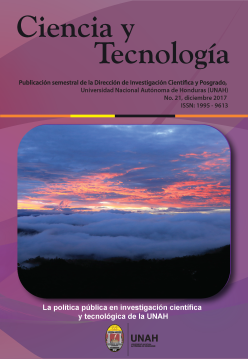Water erosion in hillside soils cultivated with no shaded coffee in Copán, Honduras
DOI:
https://doi.org/10.5377/rct.v0i20.5953Keywords:
Water erosion, surface runoff, coffee cropsAbstract
The study assesses the effects of water erosion on slope soils cultivated with no shaded coffee in the protected area named Cocoyagua, at the western department of Copan, Honduras, during the 2016 rainy season, through the estimation of variations of soil loss, of the surface runoff and of the soil nutrient content. a completely randomized design was outlined, whose treatments were coffee crop plots of three different age’s ranges, plus the comparison group, it is to say, and forest plots adjacent to coffee plantations. Experimental units were composed by runoff and erosion plots, installed at coffee cultivated and at the woods plots, with average slope of 46%. Analysis of Variance (ANOVA) results show statistical differences indicating that runoff and soil loss reduction are due to foliar density changes of the coffee plantation according to its growth process, although post hoc tests don’t show the same coincidence on all results. Correlation and regression analysis between precipitation and runoff and between this one and the soil loss indicate an intermediate positive association in both cases. In all cases, difference in runoff and soil erosion loss between woods protection and the different coffee ages is significant, demonstrating foliage capacity for intercepting and absorbing raindrops kinetic energy that cause soil particles dragging, and the potential of absorption and storage of the organic material covering the soil and of the root tissue for influencing on the soil water circulationDownloads
1155
Downloads
Published
How to Cite
Issue
Section
License
© Revista Ciencia y Tecnología
Authors who publish in this journal accept the following conditions: In accordance with the legislation of copyright, Revista Ciencia y Tecnología, recognizes and respects the moral right of authors, as well as the ownership of the patrimonial right, which will be ceded to the magazine for its diffusion in open access in printed version and in digital format. By being part of multiple indexers, databases and reference systems, the articles published by Revista Ciencia y Tecnología will be visible and will be downloaded from these websites, indicating, in all cases, the authorship of the articles, the date of publication and the number of the journal to which they correspond.




